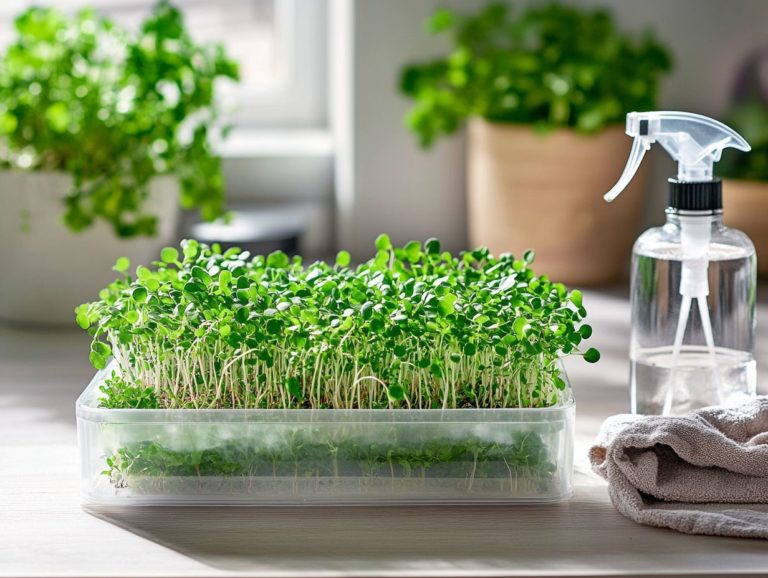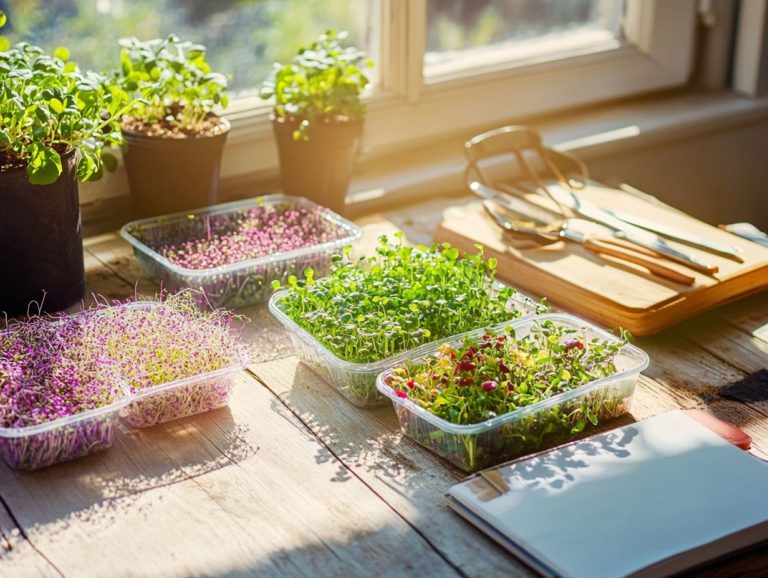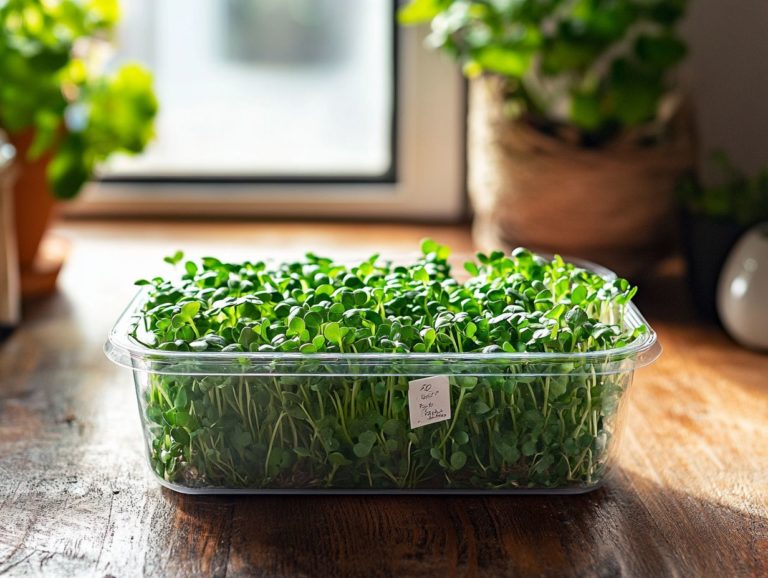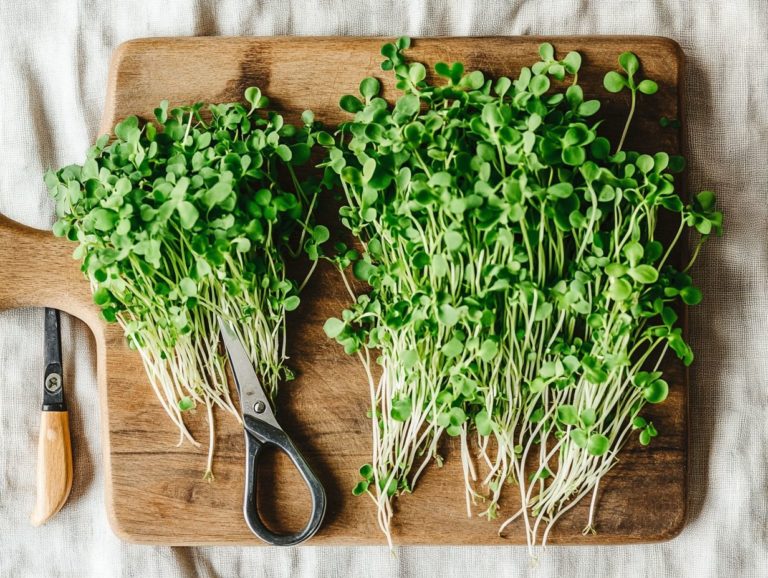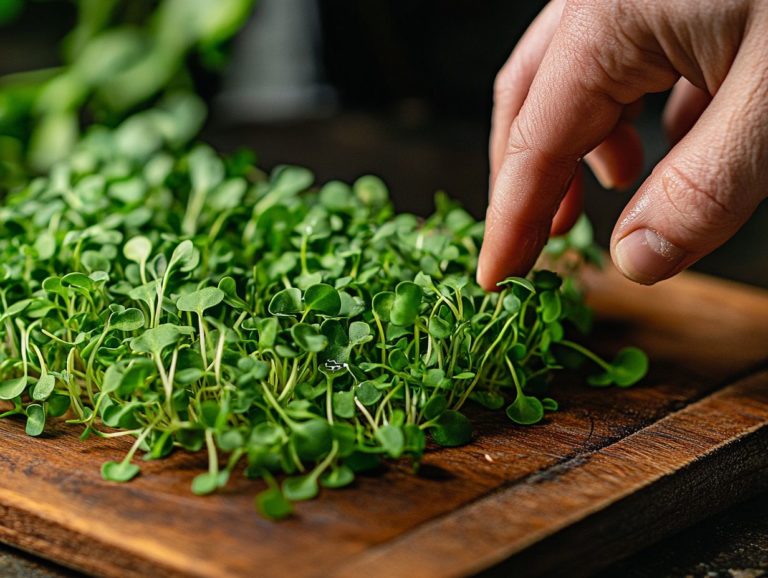How to Store Microgreens in Your Pantry
Microgreens, those vibrant and healthy foods packed with nutrients, have taken the culinary scene by storm! They are celebrated for both their exquisite flavors and remarkable health benefits.
In this article, you ll discover what microgreens are, how to store them effectively, and valuable tips to extend their shelf life.
From the ideal temperature and humidity conditions to inventive culinary applications, you’ll discover how to keep these little powerhouses fresh and seamlessly incorporate them into your meals for an invigorating burst of flavor and nutrition!
Contents
- Key Takeaways:
- What are Microgreens?
- Best Storage Practices for Microgreens
- How to Extend the Shelf Life of Microgreens
- Creative Uses for Stored Microgreens
- Frequently Asked Questions
- What are microgreens and why should I store them in my pantry?
- How should I store microgreens in my pantry?
- How long can I store microgreens in my pantry?
- Do I need to wash microgreens before storing them?
- Can I freeze microgreens for storage?
- What are some ways to use stored microgreens from the cabbage family?
Key Takeaways:

- Keep microgreens fresh by storing them in a cool and humid environment, ideally between 40-45 F and 95% humidity.
- Extend the shelf life of microgreens by using proper packaging techniques, such as airtight containers and paper towels to absorb excess moisture.
- Get creative with stored microgreens by adding them to salads, sandwiches, smoothies, and more for added flavor and nutrients. Remember to use them within 5-7 days for optimal freshness.
What are Microgreens?
Microgreens are young, edible plants that you harvest just after the first true leaves emerge, typically within a swift 7 to 21 days after germination. These healthy foods packed with nutrients are lauded for their vibrant flavors and impressive nutritional profiles.
Rich in vitamins, minerals, and antioxidants, microgreens are easy to cultivate at home and provide a sustainable source of fresh produce, enhancing your overall wellness and dietary advantages.
Definition and Benefits
Microgreens are the young seedlings of edible vegetables and herbs, harvested for their intense flavors and concentrated nutrition. They are brimming with vitamins, minerals, and antioxidants.
These tiny powerhouses also elevate your culinary experience with their vibrant colors and robust tastes. They significantly contribute to your overall health! Research indicates that certain microgreens, like broccoli and radish, contain compounds that may help lower the risk of diabetes by stabilizing blood sugar levels. After harvest, you can learn what to do with microgreens to make the most of their benefits.
Varieties such as beet and kale microgreens are celebrated for their heart-protective benefits, potentially reducing cholesterol levels and enhancing arterial function. Additionally, understanding the impact of humidity on microgreen storage is crucial for preserving their high concentration of sulforaphane, a natural compound found in some vegetables that may help fight cancer, which is particularly noteworthy.
Beyond their impressive health perks, microgreens are incredibly versatile. You can easily incorporate them into your meals! Sprinkle them on salads, blend them into smoothies, or use them as garnishes to enhance both flavor and visual appeal, enriching your dishes with their nutritional bounty. To keep your microgreens fresh, it’s important to know the best storage temperature for microgreens.
Best Storage Practices for Microgreens
Storing microgreens correctly is crucial for maintaining their freshness, nutritional advantages, and flavor. By doing so, you ensure that these vibrant greens remain a delightful and nutritious addition to your diet for as long as possible.
Temperature and Humidity Control
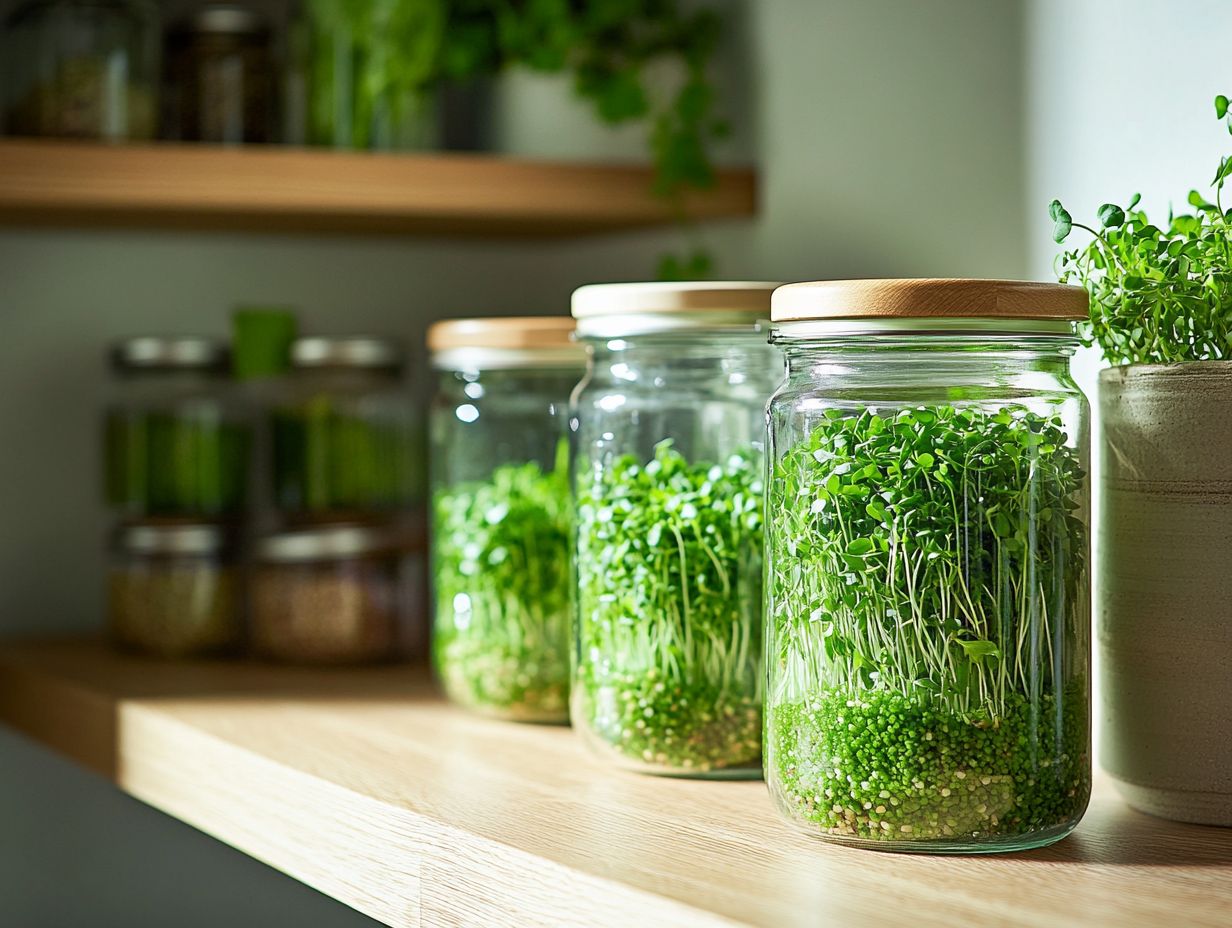
Keeping the right temperature and humidity is key to keeping microgreens fresh. Both factors play a significant role in their storage capabilities.
By keeping them in a cool environment ideally between 50 F and 60 F, you prevent degradation and maintain their vibrant colors and essential nutrients. It’s also crucial to monitor humidity levels; excess moisture can lead to spoilage, while insufficient humidity may cause wilting. For more detailed information, check out our complete guide on microgreens storage containers.
To strike that perfect balance, consider using hygrometers to keep an eye on humidity and make adjustments as needed. When storing, opt for breathable containers that promote airflow, reducing the risk of mold and spoilage.
By following these guidelines, you can ensure your microgreens stay fresh and flavorful for an extended period.
Proper Packaging Techniques
Using proper packaging techniques is essential for you to preserve the quality of your microgreens. This ensures they stay fresh and flavorful during storage.
Opt for breathable bags to enhance airflow and reduce excess moisture that might lead to spoilage. Choose containers that help with keeping moisture in check to keep your microgreens crisp and vibrant.
It’s also vital to think about ethylene, a gas from some fruits that can make microgreens wilt faster. By selecting the right packaging materials and techniques, you can effectively combat condensation, extend shelf life, and elevate the overall culinary experience. For more tips, check out storing microgreens in the refrigerator.
How to Extend the Shelf Life of Microgreens
To extend the shelf life of your microgreens, pay close attention to storage practices and methods designed to preserve their freshness, flavor, and nutritional value.
Implement these strategies, and you can enjoy the vibrant taste and health benefits of your microgreens for a longer time.
Tips for Preserving Freshness
To keep your microgreens at their freshest, embrace specific preservation techniques that focus on moisture control and temperature management.
By using straightforward strategies, you can ensure those vibrant greens maintain their crisp texture and nutritional value for an extended period. For instance, store them in containers lined with dry paper towels or include silica packets to absorb excess moisture and prevent spoilage. For more effective methods, check out these tips for washing and storing microgreens. Monitor moisture levels; too much humidity can lead to mold, while too little can cause wilting.
Avoid overcrowding in storage containers; proper airflow is crucial for preserving quality. For more information, check out these tips for storing microgreens before use to guarantee freshness and remove any unwanted leaves, ensuring a delightful and healthy culinary experience.
Creative Uses for Stored Microgreens
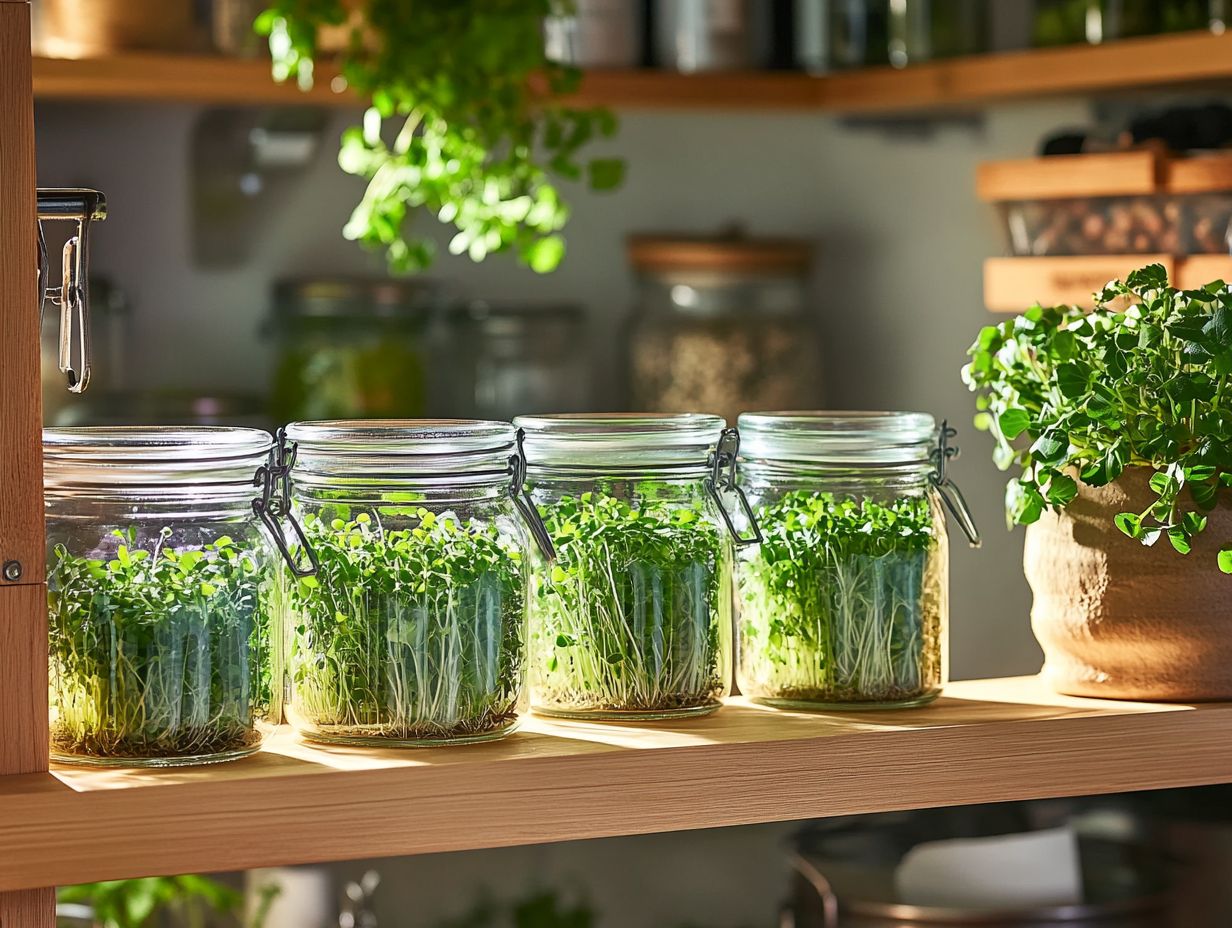
Get creative with stored microgreens in a variety of dishes to elevate flavors, add delightful texture, and enhance the nutritional profile of your meals. Their versatility makes them an invaluable addition to your cooking.
Recipes and Ideas for Incorporating Microgreens into Meals
Incorporating microgreens into your meals can elevate both flavor and nutritional value, offering great opportunities to enhance your dishes with these vibrant, nutrient-rich greens.
These tiny plants are powerhouses of vitamins, minerals, and antioxidants, making them perfect for anyone eager to boost their health while enjoying delicious food. Picture tossing a handful of radish microgreens into a salad for a delightful peppery kick or blending pea shoots into a creamy soup for added richness. To ensure you get the most out of these nutritious greens, it’s helpful to understand their shelf life.
They pair beautifully with various ingredients, from grilled meats to hearty pastas. A hint of lemon juice or a drizzle of olive oil can highlight their distinct flavors.
With such remarkable versatility, bringing these greens into your cooking can truly redefine your approach to healthy cooking.
Summary of Key Points and Final Recommendations
Microgreens are not just healthy; they’re a delicious way to boost your meals!
These tiny powerhouses are loaded with vitamins, minerals, and antioxidants. To extend their shelf life, store microgreens using the best methods for storing microgreens in a breathable container in the refrigerator, away from excess moisture.
Incorporating them into your meals is effortless; simply toss a handful into salads, blend them into smoothies, or use them as eye-catching garnishes. Their unique flavors and vibrant colors can transform everyday meals, promoting overall wellness and sustainable eating habits.
Frequently Asked Questions
Here are some common questions about microgreens:
What are microgreens and why should I store them in my pantry?
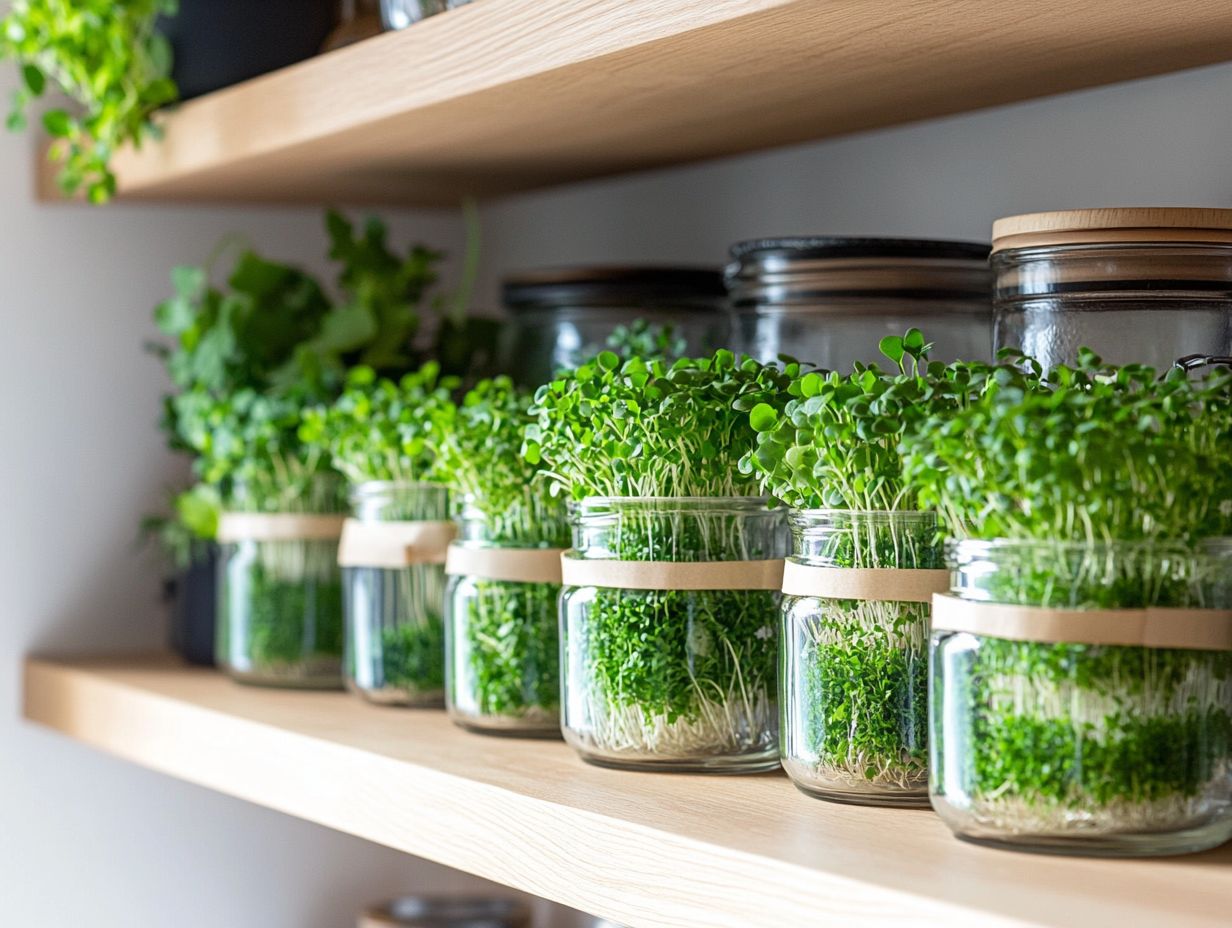
Microgreens are small, immature plants harvested after the first leaves develop. They are packed with nutrients and are a great addition to any meal. Storing them in your pantry keeps them fresh and easily accessible.
How should I store microgreens in my pantry?
To store microgreens in your pantry, you need an airtight container or a plastic bag with small holes for air circulation.
Place a paper towel at the bottom of the container. Then, spread the microgreens on top, seal the container, and store it in a cool, dark place.
How long can I store microgreens in my pantry?
Microgreens can stay fresh in your pantry for up to a week. Consume them within 2-3 days for the best flavor and nutrition. Check for freshness before using them in your meals.
Do I need to wash microgreens before storing them?
Yes, wash microgreens before storing to remove dirt and debris. Pat them dry to prevent excess moisture, which can lead to spoilage.
Can I freeze microgreens for storage?
Yes, you can freeze microgreens. However, they may lose some texture and flavor when thawed. It’s best to use frozen microgreens in cooked dishes rather than raw salads.
What are some ways to use stored microgreens from the cabbage family?
You can use stored microgreens in many delicious ways! Toss them into salads, sandwiches, smoothies, or stir-fries.
They also make tasty garnishes for soups and omelets. Enjoy experimenting with recipes to savor their freshness and health benefits!

